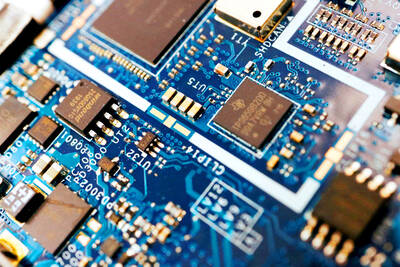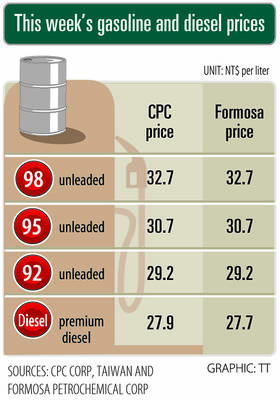Bendable mobile phones, quick-charge batteries and unbreakable touch screens — technology firms are racing to harness the potential of graphene, a wonder material that scientists say could transform consumer electronics.
A fine sheet of pure carbon, graphene is as thin as an atom, making it the skinniest material known.
At the same time though, it is 100 times stronger than steel, hugely pliable and can conduct electricity and heat better than anything else.
“There are other materials which do have one of those properties each,” said physicist Kostya Novoselov — who first isolated graphene in 2004 — last week at the Mobile World Congress, the sector’s biggest trade fair, in Barcelona.
“What is amazing here is that all those qualities are combined in one simple crystal,” he said. “Of course that immediately leaves us with a number of possible applications.”
Novoselov, a Russian-born British citizen, and his colleague at Manchester University, Andre Geim, won the Nobel Prize for their work with graphene, sparking a flurry of interest in the new material.
The number of patents involving graphene soared from less than 50 in 2004 to about 9,000 in 2014, according to Andrew Garland of research firm Future Markets, who puts out a twice-yearly report on the material.
“Most [of the patents] are in electronics,” he said.
Samsung Electronics Co, the world’s No. 1 smartphone maker, has taken out the most graphene patents — more than 490 — followed by China’s Ocean’s King Lighting Science & Technology Co (海洋王照明) and IBM Corp.
While its real-world uses so far remain modest, research into possible applications for the material picked up steam in Europe after the EU set aside 1 billion euros (US$1.1 billion at current exchange rates) in 2013 to be spent over 10 years to investigate.
“We believe we require another 10 years to get to the point where a lot of devices will start being on the market,” said Andrea Ferrari, director of the Cambridge Graphene Center at the University of Cambridge in England.
The trade fair in Barcelona for the first time had a pavilion dedicated to graphene research centers and start-ups, a sign of the growing importance of the material.
Graphene is so pliable scientists predict it will one day make flexible phones possible.
British firm FlexEnable Ltd showcased a smartwatch prototype made using graphene that wraps around a user’s wrist, while British tech firm Zap&Go Corp displayed a graphene charger for mobile phones and tablets that takes just five minutes to fully load with power.
Graphene is so strong and thin that researchers believe they will one day be able to use it to make unbreakable screens for mobile devices.
“With just a few kilos you can replace all the touchscreens in the word. With just a few layers on top of each other you can support an elephant,” the Italian Institute of Technology’s Graphene Labs director Vittorio Pellegrini said. “Graphene is really a material that allows our imagination to fly. There is no limit to what you can do.”

Hon Hai Precision Industry Co (鴻海精密) yesterday said that its research institute has launched its first advanced artificial intelligence (AI) large language model (LLM) using traditional Chinese, with technology assistance from Nvidia Corp. Hon Hai, also known as Foxconn Technology Group (富士康科技集團), said the LLM, FoxBrain, is expected to improve its data analysis capabilities for smart manufacturing, and electric vehicle and smart city development. An LLM is a type of AI trained on vast amounts of text data and uses deep learning techniques, particularly neural networks, to process and generate language. They are essential for building and improving AI-powered servers. Nvidia provided assistance

GREAT SUCCESS: Republican Senator Todd Young expressed surprise at Trump’s comments and said he expects the administration to keep the program running US lawmakers who helped secure billions of dollars in subsidies for domestic semiconductor manufacturing rejected US President Donald Trump’s call to revoke the 2022 CHIPS and Science Act, signaling that any repeal effort in the US Congress would fall short. US Senate Minority Leader Chuck Schumer, who negotiated the law, on Wednesday said that Trump’s demand would fail, while a top Republican proponent, US Senator Todd Young, expressed surprise at the president’s comments and said he expects the administration to keep the program running. The CHIPS Act is “essential for America leading the world in tech, leading the world in AI [artificial

DOMESTIC SUPPLY: The probe comes as Donald Trump has called for the repeal of the US$52.7 billion CHIPS and Science Act, which the US Congress passed in 2022 The Office of the US Trade Representative is to hold a hearing tomorrow into older Chinese-made “legacy” semiconductors that could heap more US tariffs on chips from China that power everyday goods from cars to washing machines to telecoms equipment. The probe, which began during former US president Joe Biden’s tenure in December last year, aims to protect US and other semiconductor producers from China’s massive state-driven buildup of domestic chip supply. A 50 percent US tariff on Chinese semiconductors began on Jan. 1. Legacy chips use older manufacturing processes introduced more than a decade ago and are often far simpler than

Gasoline and diesel prices this week are to decrease NT$0.5 and NT$1 per liter respectively as international crude prices continued to fall last week, CPC Corp, Taiwan (CPC, 台灣中油) and Formosa Petrochemical Corp (台塑石化) said yesterday. Effective today, gasoline prices at CPC and Formosa stations are to decrease to NT$29.2, NT$30.7 and NT$32.7 per liter for 92, 95 and 98-octane unleaded gasoline respectively, while premium diesel is to cost NT$27.9 per liter at CPC stations and NT$27.7 at Formosa pumps, the companies said in separate statements. Global crude oil prices dropped last week after the eight OPEC+ members said they would